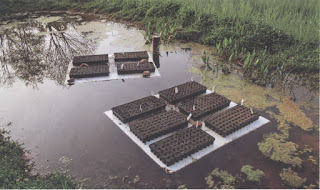A Revolutionary Permaculture-Based System Using Greenhouses, Ponds, Compost Piles, Aquaponics, Chickens, and More
In my experience farmers and gardeners aren't philosophers, they're doers. They want to know why ― but most importantly they want to know how.
In this quote, Shawn Jadrnicek summarizes what I like best about his book. When I first got into permaculture in the mid-2000s, most books were heavy on theory, but light on practice. Bill Mollison's epic Permaculture: a Designer's Manual has lots of great ideas and big claims. But good ideas on paper don't always end in good results in the real world, and details of implementation can make or break even the best ideas. For successful replication, a designer needs to know what worked and what didn't, under which circumstances. Which elements need to be included? What patterns matter?
Dave Jacke and Eric Toensmeier's Edible Forest Gardening provided the needed details, grounded in ecological science, for a field until then mostly dependent on anecdotes. Now Shawn Jadrnicek, with the help of his wife Stephanie, has applied similarly rigorous analysis to the subtitular greenhouses, ponds, compost piles, aquaponics, and chickens, all system elements popularly used by permaculture practitioners. There's plenty of information out there about how to build and manage each of these elements in isolation, and much of the permaculture literature offers good ideas for building functional relationships between them. But this book, based on experience with commercial- and home-scale areas, shares the knowledge and wisdom people need for successful integrations.
For example, Mollison and other permaculture authors suggest that chickens, greenhouses, and plants can coexist in a natural and easy combination. When temperatures get cold, chickens move into the greenhouse, adding heat when the plants need it, and improving plant growth by increasing CO2 availability. Jardnicek opens the section "Connecting Chickens to the Greenhouse" by stating:
Before implementing this project, I'd read a lot about connecting chicken coops to greenhouses ― and in theory it works. But as with all theories, the application itself presented challenges. In a nut-shell, chicken coops connected to the greenhouse are both beneficial and problematic.
After experimentation in his South Carolina location, he discovered drawbacks to the theory: plants don't use the extra CO2 at night, when the chickens spend most of their time in the greenhouse; failing to open the coop early each morning may cause heat stress to the chickens; high heat levels may dissuade the chickens from returning to the greenhouse to roost on summer nights; ammonia from poop can quickly build to levels harmful to plants; and chicken dust doesn't mix well with raw veggie crops. He concludes that northerly climates are better suited to the combination than areas with hot winter (and even hotter summer) days. In fact, in any locale, it may be better to situate a chicken coop next to the greenhouse and move filtered air, rather than try for full integration,
The book excels in its attention to detail for the many uses of water. Jardnicek addresses residential needs, crop irrigation, multi-purpose ponds, moving nutrients across the land, and even using water flushes to separate acorns from leaves, with formulas or at least approximations to guide design in each area. He thoroughly covers moving water into and out of tanks, ponds, basins, and fields, and integration with greenhouses, plant nurseries, fish, aquaculture, and chickens. One of my favorite ideas is a system of self-watering seed trays, floating in ponds on Styrofoam rafts weighted to submerge the bottoms of the trays. The detailed description gives me confidence that I could make it work for myself.Two factors prevent me from raving about the book as I did for Edible Forest Gardens and Martin Crawford's Agroforestry News. The first needn't hold back most readers: my tropical location makes much of the discussion of heat trapping and storage irrelevant. The second is more universal to anyone concerned with sustainability or self-sufficiency. Jardnicek relies heavily on industrial products: chicken and fish feed; pond liners and covers; pipes, pumps, expansion tanks, and valves; tractors and trucks; shade cloth and greenhouse plastic.
As Lierre Keith puts it in The Vegetarian Myth, "The absolute bottom line is: what methods of food production build topsoil while using only ambient sun and rain? Because nothing else is sustainable".
To be fair, much of what Jardnicek describes is for commercial-scale operations where the goal is almost always "less harm" rather than sustainability, and of course each reader needs to decide for him- or herself how much to design for true sustainability. But I think most of the described systems have unwise and irresponsible levels of industrial dependency, and the ideas need to be read with caution.
That said, I do recommend the book. I'm glad I read it, glad I have it for ongoing reference, and will likely reread it when the time comes to design my own homestead. Many of the principles and concepts could be adapted for my tropical needs and non-industrial ethics. I'm already brainstorming about seed trays floating on bamboo mats, or maybe on pond weeds...

